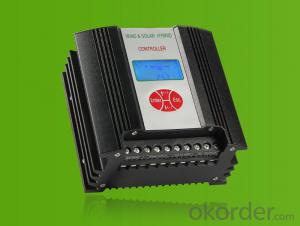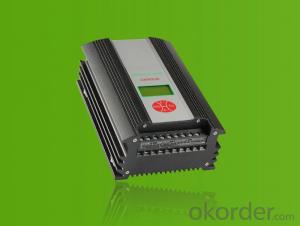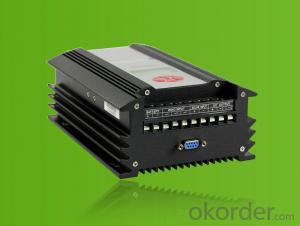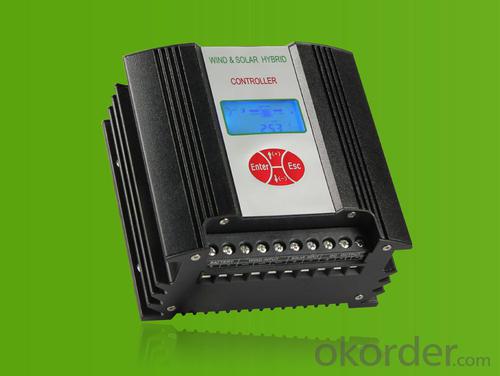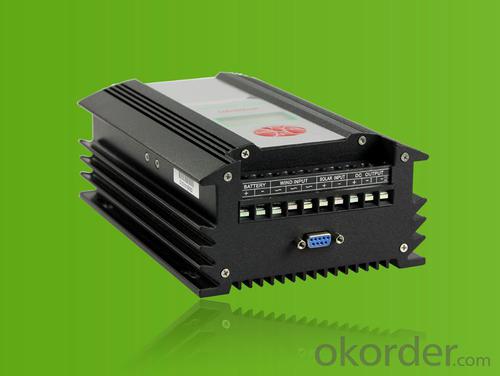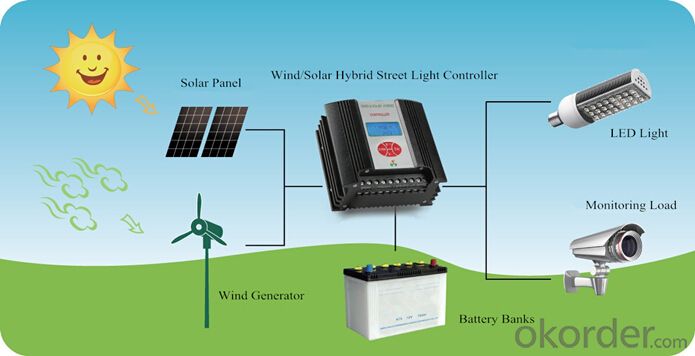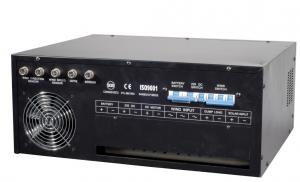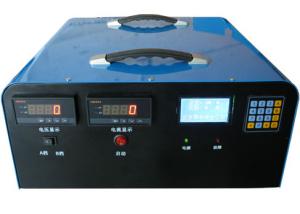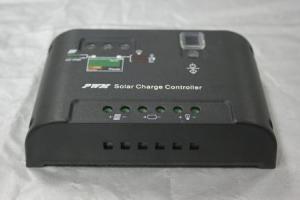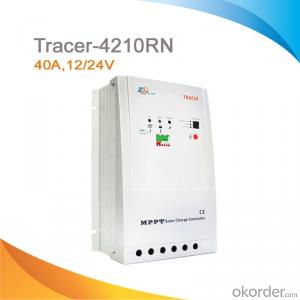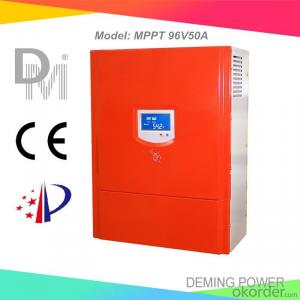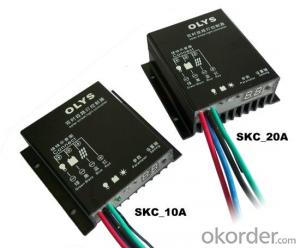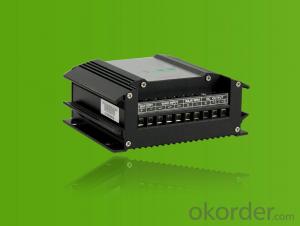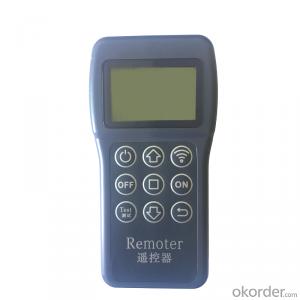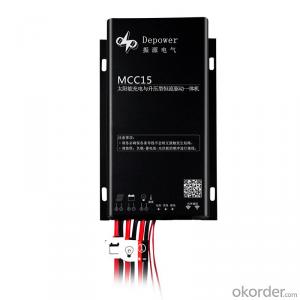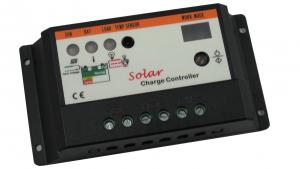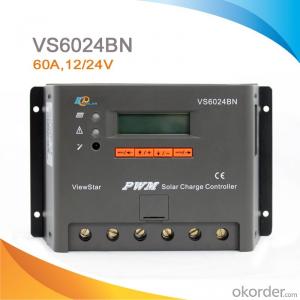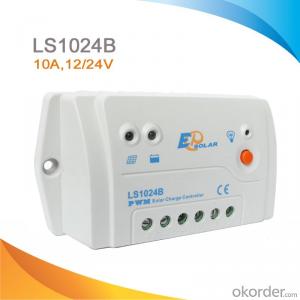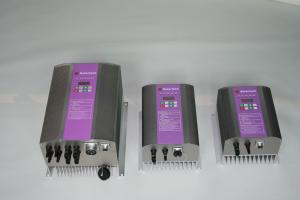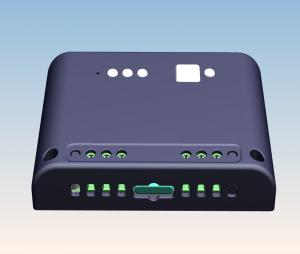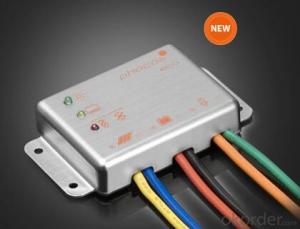Cheap MPPT Solar Controllers for Wind Solar Hybrid Street Light Controller
- Loading Port:
- Shanghai
- Payment Terms:
- TT or LC
- Min Order Qty:
- 1 unit
- Supply Capability:
- 10000 unit/month
OKorder Service Pledge
OKorder Financial Service
You Might Also Like
I. PRODUCT INTRODUCTION
The wind/solar hybrid controller is specially designed for high-end small-scale wind/solar hybrid system and especially suitable for wind/solar hybrid street light system and wind/solar hybrid monitoring system.The controller can control wind turbine and solar panel at the same time and transform the wind and solar energy into electricity for DC load use, with excess energy stored into batteries. Varieties of appearance and function design, which is flexible to meet the requirements of different customers.
II. PERFORMANCE FEATURES
Superior military-grade components to ensure the product stability.
Superior military-grade components to ensure the product stability.
Check and set all operation parameters as requirement from LCD display.
Voltage limiting and current limiting charge mode ensures battery in the best charging status.
Two DC Load output, light control, time control, constant output, and multiple output control mode selections.
PWM stepless dumpload mode, which release the excess power into dump load, making the battery charging in best status.
Design of high quality aluminum alloy appearance, with small size and good cooling effect.
III.APPLICATION AREAS
Stand alone wind/solar hybrid power station.
Stand alone domestic household wind/solar hybrid power system.
Mobile Communication base stations, expressway and other non-residential regions.
Coastal islands, remote mountainous, border posts for regions shortage of or without electricity.
Government demonstration projects, landscape lighting project, street light project etc.
IV.24V TECHNICAL PARAMETERS
Product Model | WWS03-24-N00D | WWS04-24-N00D | WWS06-24-N00D |
Rated battery voltage | 24V | 24V | 24V |
Rated wind turbine input power | 300W | 400W | 600W |
Maximum wind turbine input power | 450W | 600W | 900W |
Rated solar input power | 300W | 300W | 300W |
Dumpload Start Voltage | 27V | 27V | 27V |
Charge Shutoff Voltage | 29V | 29V | 29V |
Wind Turbine Brake Current | 15A | 20A | 30A |
Battery Under Voltage Shutoff | 21.6V | ||
Battery Under Voltage Recovery | 24V | ||
Input Over Voltage Shutoff | 32V | ||
Light Control On Voltage | 2V | ||
Light Control Off Voltage | 3V | ||
Rated Output Current of Load 1 and Load 2 | 10A | ||
Load 1 Output Control Mode | Light Control On and Light Control Off | ||
Load 2 Output Control Mode | Light Control On and Time Control 5 Hours Off | ||
Dumpload Control Mode | PWM | ||
Display Mode | LCD | ||
Protection Level | IP53(Indoor) | ||
Quiescent Current | ≤20mA | ||
Display Content | Battery Voltage, Wind Turbine Voltage, PV Voltage, Wind Turbine Current, PV Current, Wind Turbine Power, PV Power, Over Voltage, Under Voltage, Over Load, Short Circuit, Night etc status | ||
Protection Functions | Solar reverse charge protection , Solar reverse connection protection, Battery over charge protection, Battery over discharge protection, Battery reverse connection protection, Over load protection, Short circuit protection, Lightning protection Wind turbine current limiting, Wind turbine automatic brake and manual brake. | ||
Ambient Temperature | -20~+55℃ | ||
Ambient Humidity | 0~93%, without condensing | ||
Working Altitude | ≤4000m | ||
Dimension (L x W x H) | 144×152×82mm | ||
Net Weight | 1.9kg | ||
V.APPENDIX
Optional Function | ||
Ø RS232 communication function | Ø RS485 communication function | Ø Bluetooth function |
Ø Temperature compensation function | Ø By-pass function | Ø SD card function |
Ø GPRS communication function | Ø Wind speed detection function | Ø Wind turbine rotate speed detection function |
Ø Wind turbine low voltage charge function | Ø Wind turbine MPPT charging function | Ø Wind turbine low voltage charge function |
Optional Accessories | ||
Ø Ethernet Module | Ø GPRS | Ø SD card storage module |
Ø RS485-USB Converter | Ø RS485-RS232 Converter | Ø RS232-USB Converter |
Friendly reminder: Customers, who will order the wind/solar hybrid street light controller, need to provide the following information | ||
Ø Rated battery voltage | Ø Rated wind turbine power and rated solar power | Ø The wind turbine is three phase or single phase |
Qualifications | ||
Ø Utility model patent of anti-strong-wind, stepless unload wind power controller | ||
Ø Utility model patent of wind power boost charge circuit. | ||
Ø Utility model patent of SD card document storage | ||
Ø Utility model patent for integration of rectification and unload in wind power main circuit board. | ||
Ø Test Report of the ministry of information industry of posts and telecommunications industrial products quality supervision and inspection center | ||
Ø European CE certification. Ø Software product register certification | ||
In order to serve our customers better.
Our company can adjust parameters configuration according to customer’s requirement.
- Q: How does a solar controller prevent damage from reverse current flow?
- A solar controller prevents damage from reverse current flow by incorporating diodes that only allow current to flow in one direction, effectively blocking any reverse current from reaching the solar panels and causing damage.
- Q: Can a solar controller be used with a solar-powered remote sensing system?
- Yes, a solar controller can be used with a solar-powered remote sensing system. A solar controller is responsible for regulating the power output from solar panels and managing the battery charging process. In a solar-powered remote sensing system, the solar controller will ensure that the solar panels efficiently charge the batteries that power the remote sensing equipment. This helps maintain a reliable and continuous power supply for the remote sensing system, making it an essential component for its operation.
- Q: Can a solar controller be used with solar-powered waste management systems?
- Yes, a solar controller can be used with solar-powered waste management systems. A solar controller helps regulate the flow of electricity from the solar panels to the system's batteries, ensuring the batteries are charged and maintained properly. This is crucial for solar-powered waste management systems as they require a reliable power source to operate efficiently. The solar controller helps optimize the charging process and protects against overcharging or undercharging, extending the lifespan of the batteries and ensuring optimal performance of the waste management system.
- Q: How does a solar controller regulate the charging and discharging of batteries?
- A solar controller, also known as a charge controller or solar regulator, is an essential component in a solar power system that regulates the charging and discharging of batteries. Its primary function is to ensure that the batteries receive the optimal amount of charge from the solar panels and prevent overcharging or deep discharging, which can lead to battery damage. The charging process begins when sunlight is captured by the solar panels and converted into electrical energy. The solar controller connects the solar panels to the batteries and acts as an intermediary between them. It monitors the voltage and current output from the solar panels and adjusts the charging process accordingly. During the charging phase, the solar controller controls the flow of electrical energy from the solar panels to the batteries. It employs a technique known as pulse width modulation (PWM) or maximum power point tracking (MPPT) to optimize the charging efficiency. PWM adjusts the voltage and current supplied to the batteries by rapidly switching the charging circuit on and off. MPPT, on the other hand, constantly tracks the maximum power point of the solar panels to extract the maximum available power. The solar controller also incorporates various protection mechanisms to prevent battery damage. It uses voltage sensors to monitor the battery voltage and ensures that it does not exceed the recommended charging voltage. This prevents overcharging, which can lead to battery overheating or even explosion. Additionally, the solar controller monitors the battery’s state of charge and prevents deep discharging, which can reduce battery lifespan. Furthermore, a solar controller often includes additional features such as temperature compensation, load control, and display functions. Temperature compensation adjusts the charging voltage based on the battery temperature to optimize charging efficiency. Load control allows the solar controller to manage the power consumption of connected devices, ensuring that the batteries are not excessively drained. Display functions provide information about the system's performance, including battery voltage, charging current, and system status. In summary, a solar controller plays a crucial role in regulating the charging and discharging of batteries in a solar power system. It ensures that the batteries receive the optimal amount of charge from the solar panels while protecting them from overcharging and deep discharging. With its various control mechanisms and additional features, the solar controller helps maximize the efficiency and lifespan of the batteries in a solar power system.
- Q: Can a solar controller be used in a solar-powered electric wheelchair charging system?
- Yes, a solar controller can be used in a solar-powered electric wheelchair charging system. A solar controller helps regulate the charging of batteries by managing the flow of electricity from the solar panels to the batteries. In a solar-powered electric wheelchair charging system, the solar controller ensures that the batteries are charged efficiently and safely, maximizing the performance and lifespan of the batteries.
- Q: What is the maximum discharge power of a solar controller?
- The maximum discharge power of a solar controller depends on its specifications and capacity. It can vary widely, ranging from a few watts for small portable controllers to several kilowatts for larger installations.
- Q: Can a solar controller be used with a solar-powered internet connection?
- Yes, a solar controller can be used with a solar-powered internet connection. A solar controller is designed to regulate the flow of energy from solar panels to a battery, ensuring efficient charging and preventing overcharging. In the case of a solar-powered internet connection, the solar controller would manage the energy flow from the solar panels to power the necessary components of the internet connection system, such as routers or modems.
- Q: How does a solar controller handle variations in solar panel temperature?
- A solar controller handles variations in solar panel temperature by monitoring the temperature and adjusting the charging parameters accordingly. This ensures that the battery is charged optimally regardless of the temperature, preventing overcharging or undercharging.
- Q: What are the key features to look for in a solar controller?
- The key features to look for in a solar controller include maximum input voltage and current rating, efficiency, battery compatibility, charging modes, load control capability, temperature compensation, and communication options.
- Q: How do you prevent battery sulfation with a solar controller?
- Battery sulfation can be prevented with a solar controller by employing a smart charging algorithm that includes a desulfation mode. This mode periodically sends high voltage pulses to the battery, effectively breaking down any lead sulfate crystals that may have formed on the battery plates. By regularly applying this desulfation process, the solar controller helps to prevent and reverse sulfation, ensuring optimal battery performance and longevity.
Send your message to us
Cheap MPPT Solar Controllers for Wind Solar Hybrid Street Light Controller
- Loading Port:
- Shanghai
- Payment Terms:
- TT or LC
- Min Order Qty:
- 1 unit
- Supply Capability:
- 10000 unit/month
OKorder Service Pledge
OKorder Financial Service
Similar products
Hot products
Hot Searches
Related keywords
